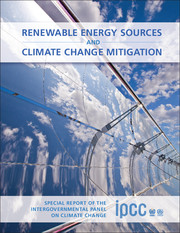 Renewable Energy Sources and Climate Change Mitigation
Renewable Energy Sources and Climate Change Mitigation Published online by Cambridge University Press: 05 December 2011
Executive Summary
Ocean energy offers the potential for long-term carbon emissions reduction but is unlikely to make a significant short-term contribution before 2020 due to its nascent stage of development. In 2009, additionally installed ocean capacity was less than 10 MW worldwide, yielding a cumulative installed capacity of approximately 300 MW by the end of 2009. All ocean energy technologies, except tidal barrages, are conceptual, undergoing research and development (R&D), or are in the pre-commercial prototype and demonstration stage. The performance of ocean energy technologies is anticipated to improve steadily over time as experience is gained and new technologies are able to access poorer quality resources. Whether these technical advances lead to sufficient associated cost reductions to enable broad-scale deployment of ocean energy is the most critical uncertainty in assessing the future role of ocean energy in mitigating climate change. Though technical potential is not anticipated to be a primary global barrier to ocean energy deployment, resource characteristics will require that local communities in the future select among multiple available ocean technologies to suit local resource conditions.
Though ocean energy resource assessments are at a preliminary phase, the theoretical potential for ocean energy easily exceeds present human energy requirements. Ocean energy is derived from technologies that utilize seawater as their motive power or harness its chemical or heat potential. The renewable energy (RE) resource in the ocean comes from six distinct sources, each with different origins and requiring different technologies for conversion: waves; tidal range; tidal currents; ocean currents; ocean thermal energy conversion (OTEC); and salinity gradients.
To save this book to your Kindle, first ensure no-reply@cambridge.org is added to your Approved Personal Document E-mail List under your Personal Document Settings on the Manage Your Content and Devices page of your Amazon account. Then enter the ‘name’ part of your Kindle email address below. Find out more about saving to your Kindle.
Note you can select to save to either the @free.kindle.com or @kindle.com variations. ‘@free.kindle.com’ emails are free but can only be saved to your device when it is connected to wi-fi. ‘@kindle.com’ emails can be delivered even when you are not connected to wi-fi, but note that service fees apply.
Find out more about the Kindle Personal Document Service.
To save content items to your account, please confirm that you agree to abide by our usage policies. If this is the first time you use this feature, you will be asked to authorise Cambridge Core to connect with your account. Find out more about saving content to Dropbox.
To save content items to your account, please confirm that you agree to abide by our usage policies. If this is the first time you use this feature, you will be asked to authorise Cambridge Core to connect with your account. Find out more about saving content to Google Drive.